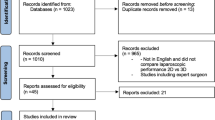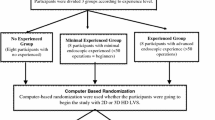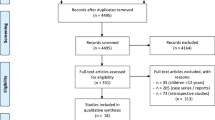Abstract
Background
Laparoscopic surgery is widely used, and results in accelerated patient recovery time and hospital stay were compared with laparotomy. However, laparoscopic surgery is more challenging compared with open surgery, in part because surgeons must operate in a three-dimensional (3D) space through a two-dimensional (2D) projection on a monitor, which results in loss of depth perception. To counter this problem, 3D imaging for laparoscopy was developed. A systematic review of the literature was performed to assess the effect of 3D laparoscopy.
Methods
A systematic search of the literature was conducted to identify randomized controlled trials that compared 3D with 2D laparoscopy. The search was accomplished in accordance with the PRISMA guidelines using the PubMed, EMBASE, and The Cochrane Library electronic databases. No language or year of publication restrictions was applied. Data extracted were cohort size and characteristics, skill trained or operation performed, instrument used, outcome measures, and conclusions. Two independent authors performed the search and data extraction.
Results
Three hundred and forty articles were screened for eligibility, and 31 RCTs were included in the review. Three trials were carried out in a clinical setting, and 28 trials used a simulated setting. Time was used as an outcome measure in all of the trials, and number of errors was used in 19 out of 31 trials. Twenty-two out of 31 trials (71 %) showed a reduction in performance time, and 12 out of 19 (63 %) showed a significant reduction in error when using 3D compared to 2D.
Conclusions
Overall, 3D laparoscopy appears to improve speed and reduce the number of performance errors when compared to 2D laparoscopy. Most studies to date assessed 3D laparoscopy in simulated settings, and the impact of 3D laparoscopy on clinical outcomes has yet to be examined.

Similar content being viewed by others
References
Buchs NC, Morel P (2013) Three-dimensional laparoscopy: a new tool in the surgeon’s armamentarium. Surg Technol Int 23:19–22
Wagner OJ, Hagen M, Kurmann A, Horgan S, Candinas D, Vorburger SA (2012) Three-dimensional vision enhances task performance independently of the surgical method. Surg Endosc 26(10):2961–2968
Medeiros LR, Stein AT, Fachel J, Garry R, Furness S (2008) Laparoscopy versus laparotomy for benign ovarian tumor: a systematic review and meta-analysis. Int J Gynecol Cancer 18(3):387–399
Sahu D, Mathew MJ, Reddy PK (2014) 3D Laparoscopy—help or hype; initial experience of a tertiary health centre. J Clin Diagn Res 8(7):NC01–NC03
Taffinder N, Smith SG, Huber J, Russell RC, Darzi A (1999) The effect of a second-generation 3D endoscope on the laparoscopic precision of novices and experienced surgeons. Surg Endosc 13(11):1087–1092
Wilhelm D, Reiser S, Kohn N, Witte M, Leiner U, Mühlbach L, Ruschin D, Reiner W, Feussner H (2014) Comparative evaluation of HD 2D/3D laparoscopic monitors and benchmarking to a theoretically ideal 3D pseudodisplay: even well-experienced laparoscopists perform better with 3D. Surg Endosc 28(8):2387–2397
Lusch A, Bucur PL, Menhadji AD, Okhunov Z, Liss MA, Perez-Lanzac A, McDougall EM, Landman J (2014) Evaluation of the impact of three-dimensional vision on laparoscopic performance. J Endourol 28(2):261–266
Kong SH, Oh BM, Yoon H, Ahn HS, Lee HJ, Chung SG, Shiraishi N, Kitano S, Yang HK (2010) Comparison of two- and three-dimensional camera systems in laparoscopic performance: a novel 3D system with one camera. Surg Endosc 24(5):1132–1143
Smith R, Schwab K, Day A, Rockall T, Ballard K, Bailey M, Jourdan I (2014) Effect of passive polarizing three-dimensional displays on surgical performance for experienced laparoscopic surgeons. Br J Surg 101(11):1453–1459
Falk V, Mintz D, Grünenfelder J, Fann JI, Burdon TA (2001) Influence of three-dimensional vision on surgical telemanipulator performance. Surg Endosc 15(11):1282–1288
Kihara K, Fujii Y, Masuda H, Saito K, Koga F, Matsuoka Y, Numao N, Kojima K (2012) New three-dimensional head-mounted display system, TMDU-S-3D system, for minimally invasive surgery application: procedures for gasless single-port radical nephrectomy. Int J Urol 19(9):886–889
Zdichavsky M, Schmidt A, Luithle T, Manncke S, Fuchs J (2014) Three-dimensional laparoscopy and thoracoscopy in children and adults: a prospective clinical trial. Minim Invasive Ther Allied Technol. doi:10.3109/13645706.2014.968171
Kunert W, Storz P, Kirschniak A (2013) For 3D laparoscopy: a step toward advanced surgical navigation: how to get maximum benefit from 3D vision. Surg Endosc 27(2):696–699
Cicione A, Autorino R, Breda A, Sio MD, Damiano R, Fusco F, Greco F, Carvalho-Dias E, Mota P, Nogueira C, Pinho P, Mirone V, Correia-Pinto J, Rassweiler J, Lima E (2013) Three-dimensional vs standard laparoscopy: comparative assessment using a validated program for laparoscopic urologic skills. Urology 82(6):1444–1450
Alaraimi B, Bakbak W, Sarker S, Makkiyah S, Al-Marzouq A, Goriparthi R, Bouhelal A, Quan V, Patel B (2014) A randomized prospective study comparing acquisition of laparoscopic skills in three-dimensional (3D) vs. two-dimensional (2D) laparoscopy. World J Surg 38(11):2746–2752
Gurusamy KS, Sahay S, Davidson BR (2011) Three dimensional versus two dimensional imaging for laparoscopic cholecystectomy. Cochrane Database Syst Rev 19(1):CD006882
Moher D, Liberati A, Tetzlaff J, Altman DG (2010) Preferred reporting items for systematic reviews and meta-analyses: the PRISMA statement. Int J Surg 8(5):336–341
Mistry M, Roach VA, Wilson TD (2013) Application of stereoscopic visualization on surgical skill acquisition in novices. J Surg Educ 70(5):563–570
Kneist W, Huber T, Paschold M, Lang H (2013) 3D virtual reality laparoscopic simulation in surgical education—results of a pilot study. Zentralbl Chir. doi:10.1055/s-0033-1350609
LaGrange CA, Clark CJ, Gerber EW, Strup SE (2008) Evaluation of three laparoscopic modalities: robotics versus three-dimensional vision laparoscopy versus standard laparoscopy. J Endourol 22(3):511–516
Sun CC, Chiu AW, Chen KK, Chang LS (2000) Assessment of a three-dimensional operating system with skill tests in a pelvic trainer. Urol Int 64(3):154–158
Mueller M, Camartin C, Dreher E, Hänggi W (1999) Three-dimensional laparoscopy. Gadget or progress? A randomized trial on the efficacy of three-dimensional laparoscopy. Surg Endosc 13(5):469–472
Herron DM, Lantis JC, Maykel J, Basu C, Schwaitzberg SD (1999) The 3-D monitor and head-mounted display. A quantitative evaluation of advanced laparoscopic viewing technologies. Surg Endosc 13(8):751–755
Hanna GB, Shimi SM, Cuschieri A (1998) Randomised study of influence of two-dimensional versus three-dimensional imaging on performance of laparoscopic cholecystectomy. Lancet 351(9098):248–251
Chan AC, Chung SC, Yim AP, Lau JY, Ng EK, Li AK (1997) Comparison of two-dimensional vs three-dimensional camera systems in laparoscopic surgery. Surg Endosc 11(5):438–440
Jones DB, Brewer JD, Soper NJ (1996) The influence of three-dimensional video systems on laparoscopic task performance. Surg Laparosc Endosc 6(3):191–197
Tanagho YS, Andriole GL, Paradis AG, Madison KM, Sandhu GS, Varela JE, Benway BM (2012) 2D versus 3D visualization: impact on laparoscopic proficiency using the fundamentals of laparoscopic surgery skill set. J Laparoendosc Adv Surg Tech A 22(9):865–870
Storz P, Buess GF, Kunert W, Kirschniak A (2012) 3D HD versus 2D HD: surgical task efficiency in standardised phantom tasks. Surg Endosc 26(5):1454–1460
Smith R, Day A, Rockall T, Ballard K, Bailey M, Jourdan I (2012) Advanced stereoscopic projection technology significantly improves novice performance of minimally invasive surgical skills. Surg Endosc 26(6):1522–1527
Honeck P, Wendt-Nordahl G, Rassweiler J, Knoll T (2012) Three-dimensional laparoscopic imaging improves surgical performance on standardized ex vivo laparoscopic tasks. J Endourol 26(8):1085–1088
Patel HR, Ribal M, Arya M, Nauth-Misir R, Joseph JV (2007) Is it worth revisiting laparoscopic three-dimensional visualization? A validated assessment. Urology 70(1):47–49
Blavier A, Gaudissart Q, Cadière G, Nyssen A (2007) Comparison of learning curves and skill transfer between classical and robotic laparoscopy according to the viewing conditions: implications for training. Am J Surg 194(1):115–121
Peitgen K, Walz M, Holtmann G (1996) A prospective randomized experimental evaluation of three-dimensional imaging in laparoscopy. Gastrointest Endosc 44(3):262–267
Votanopoulos K, Brunicardi F, Thornby J (2008) Impact of three-dimensional vision in laparoscopic training. World J Surg 32(1):110–118
Silvestri M, Simi M, Cavallotti C, Vatteroni M, Ferrari V, Freschi C, Valdastri P, Menciassi A, Dario P (2011) Autostereoscopic three-dimensional viewer evaluation through comparison with conventional interfaces in laparoscopic surgery. Surg Innov 18(3):223–230
Bittner JG, Hathaway CA, Brown JA (2008) Three-dimensional visualisation and articulating instrumentation: impact on simulated laparoscopic tasks. J Minim Acces Surg 4(2):31–38
Tevaearai HT, Mueller XM, Segesser LK (2000) 3-D vision improves performance in a pelvic trainer. Endoscopy 32(6):464–468
Kaufman Y, Sharon A, Klein O, Spiegel D (2007) The three-dimensional “insect eye” laparoscopic imaging system-a prospective randomized study. Gynecol Surg 4(1):31–34
Bhayani GL, Bhayani SB, Andriole GL (2005) Three-dimensional (3D) vision: Does it improve laparoscopic skills? An assessment of a 3D head-mounted visualization system. Rev Urol 7(4):211–214
Feng C, Rozenblit JW, Hamilton AJ (2010) A computerized assessment to compare the impact of standard, stereoscopic, and high-definition laparoscopic monitor displays on surgical technique. Surg Endosc 24(11):2743–2748
McDougall EM, Soble JJ, Wolf JS, Nakada SY, Elashry OM, Clayman RV (1996) Comparison of three-dimensional and two-dimensional laparoscopic video systems. J Endourol 10(4):371–374
Way LW, Stewart L, Gantert W, Liu K, Lee CM, Whang K, Hunter JG (2003) Causes and prevention of laparoscopic bile duct injuries: analysis of 252 cases from a human factors and cognitive psychology perspective. Ann Surg 237(4):460–469
Pietrabissa A, Scarcello E, Carobbi A, Mosca F (1994) Three-dimensional versus two-dimensional video system for the trained endoscopic surgeon and the beginner. Endosc Surg Allied Technol 2(6):315–317
Schulz KF, Altman DG, Moher D (2011) CONSORT 2010 statement: updated guidelines for reporting parallel group randomised trials. Int J Surg 9(8):672–677
Birkett D, Josephs L, Este-McDonald J (1994) A new 3-D laparoscope in gastrointestinal surgery. Surg Endosc 8(12):1448–1451
Acknowledgments
We thank Henrik Hornemann, instruction and reference librarian, the Royal Library/KUBIS, Denmark, for his assistance with developing the search string.
Disclosures
Stine Maya Dreier Sørensen, Mona Meral Savran, Lars Konge, and Flemming Bjerrum have no conflict of interest or financial ties to disclose.
Author information
Authors and Affiliations
Corresponding author
Appendix 1: Full search strategy
Appendix 1: Full search strategy
PubMed (223 articles)
Search ((((((((((((3d OR “three dimensional”) AND laparoscop* AND (training OR education OR “task performance”) NOT medline [45] )) OR (((((3d) OR ((“Depth Perception”[Mesh]) OR “Image Processing, Computer-Assisted”[Mesh] OR “Diagnostic Imaging”[Mesh:NoExp] OR “Video Recording”[Mesh:NoExp] OR “Imaging, Three-Dimensional”[Majr:noexp]))) AND (((“Endoscopy”[Majr] AND laparoscopy)) OR “Laparoscopy”[Majr] OR Laparoscopes)) AND (((((“Education”[Mesh] OR “Inservice Training”[Mesh] OR “Evaluation Studies as Topic”[Mesh:NoExp] OR “Staff Development”[Mesh]) OR “Learning”[Mesh]) OR “Surgical Procedures, Operative/education”[Mesh])) OR “Task Performance and Analysis”[Mesh] OR “Clinical Competence”[Mesh])))))))))))
EMBASE (90 articles)
3D.mp./or exp depth perception/or image processing/or exp *three dimensional imaging/AND exp *laparoscopy/or Laparoscopy.mp./AND exp medical education/or exp clinical competence/or exp in service training/or exp training/or exp staff training/or exp surgical training/or exp task performance
Cochrane Library (28 articles)
(“3D” or “depth perception” or “three dimensional imaging”) and (“laparoscop*”)
In Title, Abstract, Keywords in Cochrane Reviews’
Rights and permissions
About this article
Cite this article
Sørensen, S.M.D., Savran, M.M., Konge, L. et al. Three-dimensional versus two-dimensional vision in laparoscopy: a systematic review. Surg Endosc 30, 11–23 (2016). https://doi.org/10.1007/s00464-015-4189-7
Received:
Accepted:
Published:
Issue Date:
DOI: https://doi.org/10.1007/s00464-015-4189-7




